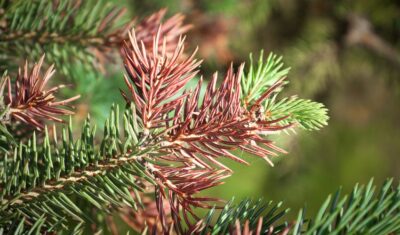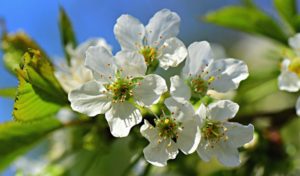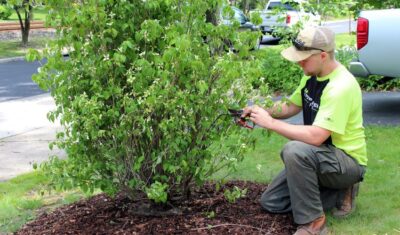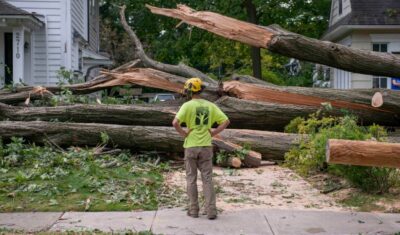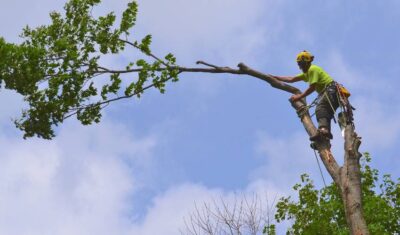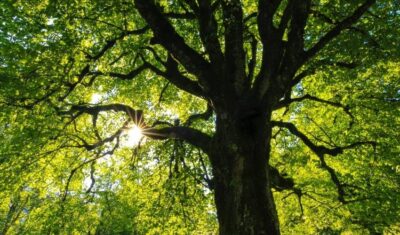When trees are overgrown, damaged, or not looking their best, you might want to prune them NOW. But what if it’s summer – can you still prune trees when temperatures heat up in northeast Ohio?
The quick answer is “yes,” you can do some types of tree pruning in summer. But it’s important to understand the limitations of summer pruning and, more importantly, which trees should NOT be trimmed in summer. Keep reading for all the details!

Summer Tree Pruning? Yes, You Can!
Most people know that it’s good to prune trees in winter when trees are dormant. But did you know that you can also prune (some of) your trees in summer?
Reasons to Prune Trees in Summer
You can think of summer tree pruning as the final step of your annual tree care cycle. It’s done when winter’s structural pruning has filled in after spring’s fertilizing and mulching has generated new growth, and before fall’s brilliant color display and leaf drop.
Summer tree pruning differs from winter pruning in several important ways. Rather than doing major structural work, summer pruning is good for:
- Opening up a tree’s crown to more sunlight
- Refining the shape of a tree but not changing its structure
- Removing rapid spring growth that’s making the tree too large or unbalanced
- Removing damaged or diseased branches
- Keeping tree canopies away from buildings and utility lines
Opening a Tree’s Crown
Summer is a good time to remove lateral, or side, branches. Removing some lateral branches will increase the amount of sunlight and air that reach interior leaves and branches. This increased airflow and sunlight help to reduce fungal diseases and improve fruit ripening.
Shaping a Tree’s Crown
In summer, you can prune to improve the shape of your tree, as well as to shape your views.
When tree branches are fully leafed out, you can see the tree’s overall form and size. That makes it easier to choose the exact branches you want to remove or refine. The goal is to cut off only just enough to achieve the shape you want or give you a better view. We’re NOT talking about tree topping or a severe reduction in size!
NOTE: It’s generally a good idea to do major structural pruning in winter; think of summer pruning as a finishing touch.
Removing Problem Branches
Summer pruning can keep your trees healthy and vigorous by removing branches that have:
- Died or not emerged from dormancy
- Developed diseases, such as fire blight
- Grown too large or become unbalanced
- Blocked access to a walkway, driveway, patio, etc.
- Crossed other branches, grown inward, or begun rubbing off the bark
- Broken, cracked, split, are hanging, or are otherwise damaged
PRO TIP: Before starting to prune your trees in summer, evaluate weather conditions and follow best practices to avoid injuring or stressing your trees.
Safety and Canopy Clearance
It’s always best to keep trees away from buildings and utility lines. Pruning your trees for clearance is easier in summer because trees have fully leafed out. You can clearly see the extent of your tree’s crown and prune out precisely what’s required to keep a safe distance.
While we all appreciate the shade of trees in summer, a little pruning will help prevent summer storm damage and utility outages by keeping tree crowns well-shaped and balanced, and safely away from the property and overhead wires.
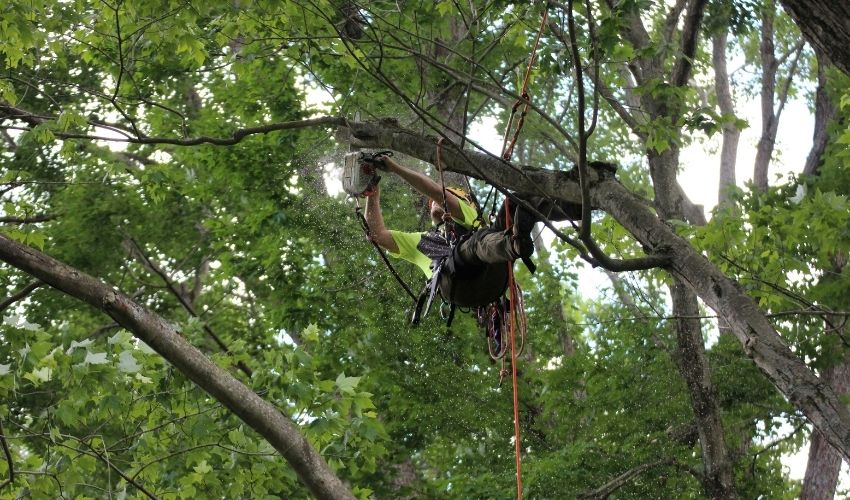
The Best Time to Prune Trees in Summer
One of the main considerations when summer pruning trees here in Northeast Ohio is heat stress. You’ll want to avoid stressing your tree with both pruning cuts (wounds) and heat (or water) stress at the same time.
In summer, healthy trees can start sealing off wounds from pruning cuts while continuing to put out leaves and make energy from sunlight. But if the tree is struggling with heat stress, summer pruning may be too damaging.
The best time to prune is in early summer before temperatures have reached their peak.
But before you sharpen your shears, there are a few other things to consider:
- Are the terminal buds set? After trees have put out all their spring leaves, they set a bud at the end of their branches. This is the sign that no more leaves will be made, and summer pruning won’t stimulate lots of new leaf growth. Ideally, prune after terminal buds are set.
- When does the tree flower? For spring-flowering trees and shrubs, prune before they set their future flower buds. If you prune these buds, you’ll have fewer (or no!) blooms next spring. Prune spring-blooming trees just after flowering.
We encourage everyone who wants to learn to prune trees to do so. But always be sure you know your trees and their annual cycles of growth before you start pruning!
Trees That Should be Pruned in Summer
While nearly all trees can be pruned in summer, there are some that benefit from pruning during these warmer months.
“Sappy” Trees
In summer, you can safely prune hardwood trees that naturally produce a lot of sap, such as:
- Birch (Betula species)
- Maples (Acer species)
- Walnut (Juglans species)
These trees produce and distribute much less sap to their branches in summer, so your pruning cuts won’t weep sap as they would in late winter or early spring.
Fruit Trees
When you prune your fruit trees in summer, you slow down leafy growth and give a boost to fruiting.
For fruit trees, summer pruning is beneficial for three reasons:
- It stimulates bud growth for the following year’s flowering.
- It brings sunlight to more branches. Fruit tree branches need direct sunlight to produce flowers and fruit buds.
- It helps control the growth of suckers and water sprouts.
Increasing sunlight will also help ripen fruit but be sure to keep a leafy crown so that tender-skinned fruits do not get sunburned.
NOTE: Most fruit trees benefit from a heavier pruning during the dormant season; summer pruning requires a lighter touch.
Trees That Should Not be Pruned in Summer
Summer tree trimming can create opportunities for insects and diseases to damage or kill your trees. Always follow these rules when pruning in summer:
- Never prune when insect pests and tree pathogens are present.
- Always sterilize your pruning tool blades (ideally, between cuts but, at a minimum, between trees).
Even when following these best practices, avoid pruning the following trees in summer (unless it’s required due to failure or other damage).
Oaks
Oak wilt, the fatal fungal disease that continues to spread across the Midwest and eastern states, has no cure. Fresh pruning cuts attract the beetles that carry oak wilt fungus so it’s critical not to prune while the beetles are active (April through October). If you must cut oak trees in summer, paint the wounds with special tree paint. It’s vital that we all do our part to slow the loss of oaks and maintain our forest diversity and our specimen trees.
Elms
Elms require similar treatment; wait until fall to prune them. Dutch elm disease affects elm trees throughout northeast Ohio. It’s a fatal disease with no cure that is still spreading around the world.
While healthy oaks and elms can be treated systemically with fungicides, this treatment is preventative, lasts for only a limited time, and is not a cure.
Trees Put Out a Lot of Leaves!
Each spring, the new buds on trees remind us that winter is over and summer is on its way. From the first haze of pale green that surrounds a tree when its leaves begin to appear to the deep, leafy shade of midsummer, leaves continue to amaze us with their abundant growth and complex structure.
Many of our beloved Ohio trees are remarkable leaf-making machines. Because of this, we recommend that homeowners (or tree owners) keep an eye out for rapid growth that can take over a tree. Depending on the age, species, and vigor of your trees, you may find that what was a tidy springtime tree has become an overgrown summer tree.
A Final Word
Winter pruning is done to keep a tree’s branch structure, height, and crown size in balance. But vigorous tree growth in spring can easily overtake and unbalance a tree that was carefully shaped in winter.
If you see your trees heading into summer and looking dense, uneven, or just plain huge, schedule some summer pruning to open their canopy and improve their shape.
Overly long branches and branches weighed down with exuberant foliage are more likely to break during summer storms, which may result in structural damage that requires corrective pruning.
To avoid this costly and stressful (for you and for your tree) work, have your trees regularly inspected and pruned. Some preventive care can ensure your trees have a long life and a natural-looking form.
Schedule Your Professional Tree Pruning
Contact Independent Tree today to schedule your tree pruning or trimming. We can also advise you on the best time of year to prune the trees and shrubs on your property.Recent Articles
Topics
About The Author

STAY IN THE LOOP
WITH OUR
LATEST UPDATES
"*" indicates required fields

